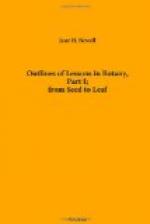[Footnote 1: The New Botany. By W.J. Beal. Philadelphia, C.H. Marot, 814 Chestnut St., 1882. Page 5.]
HORSECHESTNUT (AEsculus Hippocastanum).
We will begin with the study of a branch of Horsechestnut.[1] The pupils should examine and describe their specimens before discussing them in the class-room. They will need some directions and hints, however, to enable them to work to any advantage. Tell them to open both large and small buds. It is not advisable to study the Horsechestnut bud by cutting sections, as the wool is so dense that the arrangement cannot be seen in this way. The scales should be removed with a knife, one by one, and the number, texture, etc., noted. The leaves and flower-cluster will remain uncovered and will be easy to examine. The gum may be first removed by pressing the bud in a bit of paper. The scholars should study carefully the markings on the stem, in order to explain, if possible, what has caused them. The best way to make clear the meaning of the scars is to show them the relation of the bud to the branch. They must define a bud. Ask them what the bud would have become the next season, if it had been allowed to develop. It would have been a branch, or a part of one. A bud, then, is an undeveloped branch. They can always work out this definition for themselves. Conversely, a branch is a developed bud, or series of buds, and every mark on the branch must correspond to something in the bud. Let them examine the specimens with this idea clearly before their minds. The lesson to prepare should be to write out all they can observe and to make careful drawings of their specimens. Ask them to find a way, if possible, to tell the age of the branch.
[Footnote 1: The pupils should cut their names on their branches and keep them. They will need them constantly for comparison and reference.]
At the recitation, the papers can be read and the points mentioned thoroughly discussed. This will take two lesson-hours, probably, and the drawing may be left, if desired, as the exercise to prepare for the second recitation.




